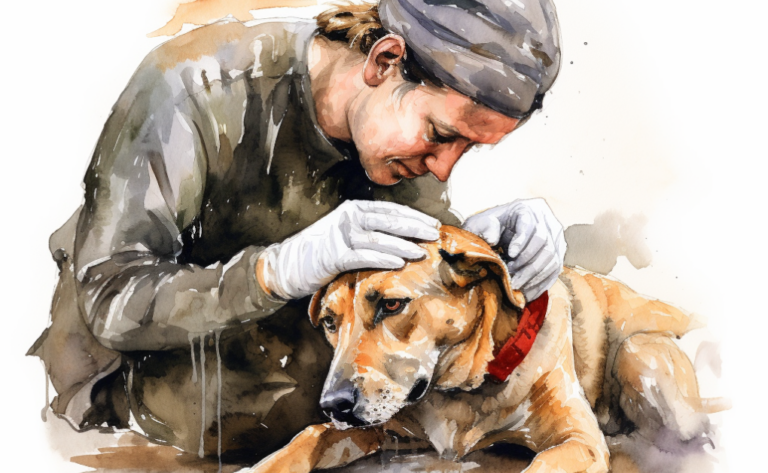What are Common Genetic Diseases in Dogs?
What is it?
How is it Treated?
Breed Predispositions
Labrador Retrievers German Shepherds Bulldogs Golden Retrievers Boxers Beagles Dachshunds Cocker Spaniels
Introduction
As a proud new dog owner, Jessica had been eagerly preparing for the arrival of her adorable Dachshund puppy, Benny. She had researched everything from puppy-proofing her home to the best training methods, hoping to give Benny the perfect start in life. However, during one of Benny’s routine check-ups, the veterinarian mentioned that certain dog breeds, including Dachshunds, were prone to specific genetic diseases. Concerned, Jessica asked the vet to run additional tests to ensure Benny’s long-term health. When the results came back, she was disheartened to learn that Benny had a genetic disease common in his breed.
Dogs, our beloved companions, come in various shapes, sizes, and breeds. While each breed has its unique characteristics, it can also be predisposed to certain genetic diseases. Understanding common genetic disorders in dogs is essential for pet owners and breeders alike, as it allows for informed decision-making, early detection, and proper management of these conditions.
Certain giant breeds are predisposed to specific genetic diseases, while other pure breed populations are more prone to them. For instance, German Shepherds and Labrador Retrievers are susceptible to hip dysplasia, an inherited disorder, and Golden Retrievers are prone to elbow dysplasia.
Several types of genetic diseases are common in dogs caused by different genetic variants. Some are congenital, meaning they appear at birth. Others develop later in life because of their genetic background. Some are even caused by environmental factors such as nutrition, stress, or toxins.
Causes of Genetic Disease in Dogs
Genetic diseases in dogs are conditions caused by genetic predispositions and result from mutations within an individual dog’s DNA. These diseases affect the health and lifespan of the canine population. Some genetic diseases are inherited, meaning one parent passes down a defective gene to offspring, while others are acquired, meaning the dog acquires the mutation after birth.
Here are some common genetic variants affecting various dog breeds:
- Hip Dysplasia: Commonly found in German Shepherds, Labrador Retrievers, and Saint Bernards, this condition causes pain and arthritis in the hips. It occurs when the ball joint between the femur and pelvis becomes dislocated, causing leg bones to rub together, leading to inflammation and bone damage.
- Von Willebrand Disease: Affecting blood clotting, this condition is most commonly seen in puppies under six months old, including Scottish Terriers and Staffordshire Bull Terriers. If a puppy has VWD, it may bleed excessively when injured.
- Progressive Retinal Atrophy (PRA): A rare inherited disease causing blindness in affected animals like Golden Retrievers and Australian Cattle Dogs. The retina’s photoreceptor cells gradually die off, causing gradual loss of sight.
- Patella Luxation (PL): Common in Old English Sheepdogs and French Bulldogs, this condition causes pain and lameness when the kneecap becomes dislocated from its socket in the femur.
- Epilepsy: Characterized by seizures, epilepsy is often associated with other medical problems like kidney failure, liver disease, and thyroid disorders in breeds such as Rottweilers and English Bulldogs.
- Elbow Dysplasia: This condition, causing painful swelling and deformity of the elbows, occurs most commonly in Golden Retrievers, Labrador Retrievers, and Collies.
- Cranial Cruciate Ligament Disease: Affecting breeds like Greyhounds, Irish Setters, and Whippets, this condition causes joint laxity and instability.
- Chondrodystrophy: Common in Dalmatians, Cocker Spaniels, and Yorkshire Terriers, this condition affects cartilage tissue growth and results in shortened limbs.
- Degenerative Joint Disease: Often occurring in Old English Sheepdogs, Australian Kelpies, and Bichon Frises, this condition causes arthritis and stiffness in joints.
- Hypothyroidism: Affecting Golden Retrievers and Labradors, this condition causes low thyroid hormone levels.
- Diabetes Mellitus: Common in Golden Retrievers, Labrador Retrievers, and Siberian Huskies, this condition causes high sugar levels in the bloodstream.
- Color Blindness: Occurring most often in Border Collies, Golden Retrievers, and Labrador Retrievers, this condition causes difficulty distinguishing between red and green objects.
- Cataracts: Cloudy eyesight issues leading to blindness if left untreated, affecting breeds such as French Bulldogs and Bull Terriers.
- Glaucoma: This eye condition leads to vision loss over time, affecting breeds like Newfoundlands and Brachycephalic dogs.
- Spinal Cord Injury: Often occurring in Greyhounds, Cocker Spaniels, and Bull Terriers, this condition causes paralysis.
- Muscular Dystrophy: Affecting breeds like Toy Poodles, Miniature Schnauzers, and Chihuahuas, this condition causes muscle weakness.
- Myxomatous Mitral Valve Disease: A common heart issue in breeds like Scottish Terriers and Staffordshire Bull Terriers.
- Brachycephalic Obstructive Airway Syndrome: Affecting brachycephalic breeds such as English Bulldogs and French Bulldogs.
- Degenerative Myelopathy: Common in breeds like the German Shepherd and Rottweiler, this condition affects the spinal cord, leading to progressive paralysis.
By understanding these genetic diseases, dog owners can be better prepared to address and manage them.
Symptoms of Canine Genetic Disorders
Symptoms of genetic diseases in dogs can vary significantly depending on the specific condition. Some signs may be more evident, such as vomiting, diarrhea, lethargy, seizures, or blindness. In contrast, others, like behavioral problems, joint pain, or weight loss, may be less noticeable.

Here are some common symptoms of hereditary diseases in dogs to watch out for:
- Hip Dysplasia (HD)
Dogs with HD often show symptoms like limping, stiffness, difficulty getting up after lying down, reluctance to jump, and abnormal gait patterns. While HD is typically associated with larger dogs, it can also occur in smaller breeds and mixed-breed dogs. For example, Saint Bernards have an almost 50% chance of developing the disease.
- Epilepsy
The primary symptom of epilepsy is a seizure resulting from excessive neuron discharge in the brain. This can cause sudden involuntary movements, loss of consciousness, convulsions, stiffening muscles, jerking limbs, and sometimes even death.
- Cataracts:
The most common symptom of cataracts is blurred vision. Other symptoms include glare, halos around lights, double vision, difficulty reading, and loss of night vision.
- Deafness
Symptoms of deafness vary based on the cause. For example, nerve damage may result in tinnitus (ear ringing), while bone conduction issues may lead to balance problems.
- Retinal Degeneration
Symptoms of retinal degeneration depend on the type of disease involved. In some cases, no visible signs appear until the advanced stages. The first symptom is usually night blindness, followed by gradual deterioration of peripheral vision.
- Progressive Retinal Atrophy (PRA):
Common signs include night blindness, difficulty seeing in low light conditions, and lack of reaction to bright sunlight. Symptoms of PRA in dogs vary depending on the breed, with some breeds like Labrador Retrievers, Golden Retrievers, German Shepherds, Doberman Pinschers, and French Bulldogs showing early onset of symptoms.
- Glaucoma
Vision changes such as blurring, double vision, or decreased vision are symptoms of glaucoma.
- Spinal Cord Injury
Symptoms vary depending on the injury sustained, including loss of sensation, paralysis, weakness, numbness, and tingling in the arms and legs.
Signs of PL include difficulty getting up after lying down, painful swelling around the knee, and limping when standing.
Understanding the symptoms of common hereditary diseases in dogs can help owners recognize potential issues early. It is essential to consider genetic diversity and disease liability genes when breeding dogs to reduce the risk of congenital conditions. Regular check-ups with a veterinarian can help monitor your dog’s health and catch any problems early.
Diagnosis of Common Genetic Disorders in Dogs
- Physical examination: A thorough physical examination helps the vet assess the overall health of the dog, such as brachycephalic dogs, which may have unique health issues, and detect any abnormalities or signs of disease.
- Medical history: The vet will gather information on the dog’s medical history, including vaccination records, previous illnesses, and any ongoing medications. This information is essential for breeds like golden and Labrador retrievers, prone to specific health issues.

- Blood tests: Blood tests can be used to evaluate organ function, check for infections, and identify abnormalities in blood cells. These tests help diagnose common diseases that dogs often face.
- Urinalysis: A urinalysis helps detect urinary tract infections, kidney issues, and other conditions affecting the urinary system, which can be prevalent in purebred dogs.
- Radiography (X-rays): X-rays can reveal abnormalities in the dog’s bones, organs, and other internal structures, including those that do not show obvious external symptoms.
- Ultrasound: An ultrasound uses sound waves to create detailed images of the dog’s internal organs, allowing the vet to detect issues such as tumors, cysts, or organ enlargement in breeds susceptible to these conditions.
- Endoscopy: Endoscopy involves inserting a thin, flexible tube with a camera into the dog’s body to examine internal structures, such as the gastrointestinal tract or airways.
- Biopsy: A biopsy involves taking a small tissue sample for further examination under a microscope, which can help identify cancerous cells or other abnormalities related to ancient disease liability genes.
- Genetic testing: Genetic tests can identify specific gene mutations or markers associated with certain hereditary conditions, like disease liability genes that preceded domestication. Breeders should select dogs for breeding that do not carry these mutations to minimize the risk of passing them on to future generations.
Using these diagnostic tools and methods, veterinarians can accurately diagnose common diseases in dogs and develop appropriate treatment plans to manage their conditions effectively.
Treatment for Canine Genetic Disorders
Veterinarians use a variety of treatment options to address common genetic diseases in dogs, with the primary focus on managing symptoms, slowing disease progression, and enhancing the pet’s quality of life. Here’s an overview of some strategies veterinarians employ to treat prevalent genetic diseases in dogs:
- Targeted Medications: Veterinarians may prescribe medications designed to manage symptoms or decelerate disease progression depending on the genetic condition. For example, certain breeds prone to heart diseases can benefit from medications that support heart function and improve the dog’s overall health.
- Nutritional Management: A personalized diet plan can help manage specific genetic diseases by addressing nutritional deficiencies or avoiding certain ingredients that can exacerbate the condition. Veterinarians might recommend a diet with particular nutrient ratios or supplements to cater to the dog’s needs.
- Physical Therapy and Rehabilitation: For dogs with genetic musculoskeletal or neurological disorders, physical therapy and rehabilitation can help enhance mobility, maintain muscle mass, and alleviate pain. Veterinarians often collaborate with certified canine rehabilitation therapists to develop a tailored program for the dog.
- Supportive Care: In some instances, the treatment focuses on maintaining the dog’s quality of life through supportive care. This may involve managing pain, providing nursing care, administering fluids, and regularly monitoring the dog’s condition.
- Surgical Intervention: In specific cases, surgical intervention may be necessary to treat or manage the genetic condition. For example, dogs with hip dysplasia might require surgery to relieve pain and improve mobility.
- Genetic Counseling: For dog owners considering breeding, genetic counseling can help evaluate the genetic risk of passing on genetic diseases to offspring. Veterinarians might recommend DNA testing and advise on responsible breeding practices to minimize the spread of genetic conditions.
- Regular Monitoring: Consistent check-ups and monitoring are crucial for managing dog genetic diseases. Veterinarians may recommend periodic blood tests, imaging studies, or other diagnostic procedures to track the dog’s condition and adjust the treatment plan accordingly.
By working closely with a veterinarian and following a tailored treatment plan, pet owners can effectively manage their dog’s genetic condition and ensure the best possible quality of life. This approach is particularly important given the expression of genetic diseases dispersed in domestic dogs due to the separation of breeds and the fact that dogs are only bred within their breed.
Prevention of Genetic Disorders in Dogs
Preventing genetic diseases in dogs involves responsible breeding practices, early detection, and awareness of potential health issues. While it’s impossible to eliminate all genetic diseases, you can minimize the risks by taking the following steps:
- Research Breeds: Before acquiring a dog, research the breed’s predisposition to specific genetic conditions, whether purebred or mixed-breed dogs. This knowledge will help you make an informed decision and prepare for potential health issues, whether canine hip dysplasia in German Shepherd dogs or heart issues in Cavalier King Charles Spaniels.
- Choose a Reputable Breeder: Select a reputable breeder who prioritizes the health and welfare of their dogs. Responsible breeders should select dogs free of known hereditary issues and conduct genetic testing before breeding.
- Review Pedigrees and Health Tests: Request information about the health of the dog’s parents and their pedigrees. Reputable breeders should provide documentation of genetic testing and health clearances for both parents.
- Genetic Testing: Perform genetic testing on your dog if it’s part of a breed predisposed to specific genetic conditions. Early detection can help you manage the inherited condition more effectively and prevent complications.
- Spaying and Neutering: If you’re not planning on breeding your dog, consider spaying or neutering to prevent the spread of genetic diseases. This can also provide health benefits for your pet, such as reducing the risk of certain cancers.
- Maintain a Healthy Lifestyle: A healthy lifestyle can help support your dog’s overall health and minimize the impact of genetic diseases. Provide a balanced diet, regular exercise, and routine veterinary care to keep your dog healthy.
- Regular Veterinary Check-ups: Schedule consistent veterinary check-ups to monitor your dog’s health and detect any early signs of genetic conditions, including those that do not show obvious symptoms. Early detection and intervention can help manage the disease and improve your dog’s quality of life.
- Educate Yourself: Stay informed about potential genetic diseases of dogs and advancements in veterinary medicine, including the latest research on the domestic dog genome. This knowledge can help you make informed decisions about your dog’s health and well-being.
By taking these steps, you can minimize the risk of genetic diseases in your dog and contribute to the overall health and welfare of the canine population. In doing so, you can help address common traumatic injuries and other concerns dogs face, improving their quality of life.
Frequently Asked Questions
Disclaimer: The information provided on this veterinary website is intended for general educational purposes only and should not be considered as a substitute for professional veterinary advice, diagnosis, or treatment. Always consult a licensed veterinarian for any concerns or questions regarding the health and well-being of your pet. This website does not claim to cover every possible situation or provide exhaustive knowledge on the subjects presented. The owners and contributors of this website are not responsible for any harm or loss that may result from the use or misuse of the information provided herein.







